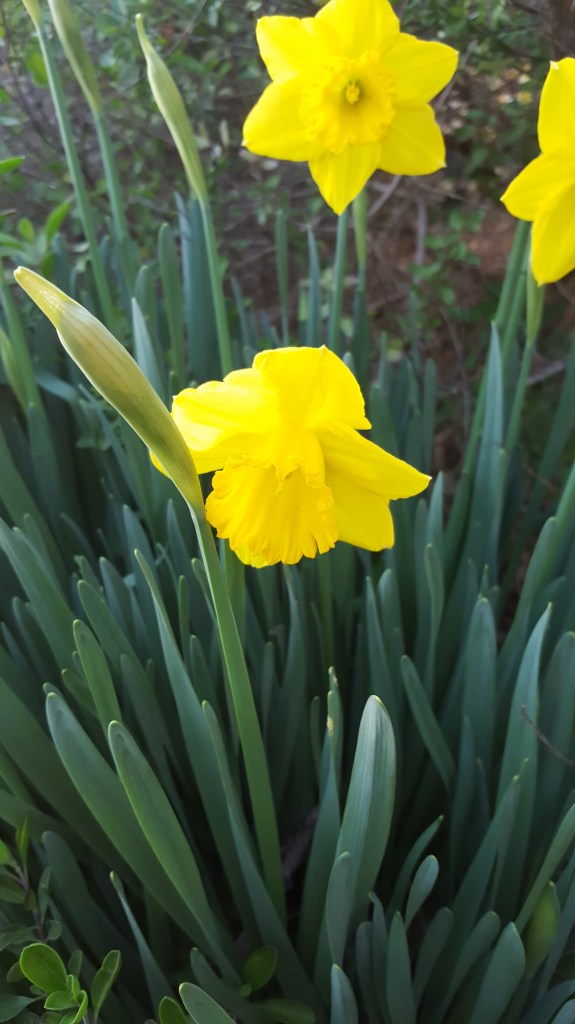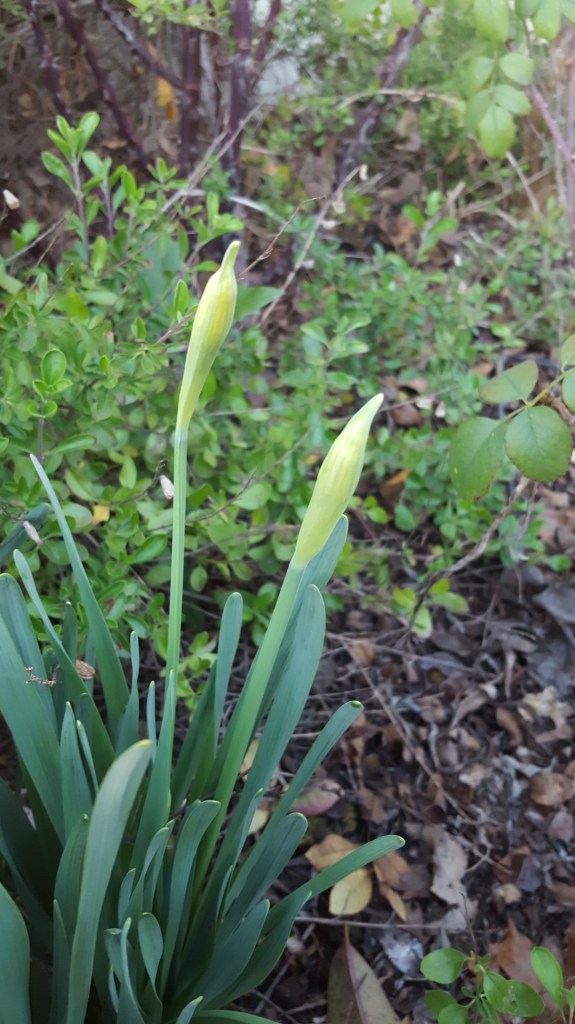
Since moving into our home in 2007, we have systematically removed nearly every tree, plant, and lawn that was originally here. Our daffodils are one of the few surviving remnants planted at some point by one of the many prior owners of our home.
(All links open a new page, so you won’t lose your spot when you look around! Get information on gardening and cultural traditions, recipes, stories, and more!)
A handy growing summary chart is at the end of the article.
Seriously, what were they thinking?
The are multiple reasons for this complete transformation of our growing space. In some cases there were trees planted ridiculously close to the house and the power lines that run behind our property. In no way should trees that grow 40 feet tall and wide be planted 10 feet from each other and five feet from a structure! Trees that are prone to dropping massive quantities of leaves and/or needles should never be planted around a swimming pool! And trees that drop ankle rolling seed pods should not be planted where people will walk! Ugh!

In addition to the bad planning of past transgressors, the landscape was rather lackluster. Nice, but bland. We wanted to perk things up and in the process create an edible garden for ourselves and the local pollinators. Over time nuisance trees were replaced with carefully planned fruit trees, shrubs with raised garden beds and herb gardens, and lawns with various flowering and drought tolerant plants.
For the longest time, I would see these random green spears poking out of the ground each spring, but nothing more. There were no blooms to help me identify what they were. Based on the growth patterns and timing, I knew it was a bulb of some sort but that was all that I could determine. Finally after the removal of one of the badly placed trees, the increased sunlight allowed these plants to finally show what they were: daffodils. And lots of them! The heavy shade had kept them from getting the light needed to bloom.
Daffodil is the common name that is used to refer to a wide variety of bulbing plants, all with the signature feature of a circle of petals with a cup like protrusion in the front. They look much like a teacup with no handle, sitting on a saucer. The scientific name for this group of plants is Narcissus, and it also includes flowers called “paperwhites” (Narcissus papyraceus). Often, though, the label “daffodil” is used for spring blooming bulbs with roughly 2 inch across flowers in various shades of yellow, orange, cream, and pink. Some have a sweet scent, and they are attractive plants for bees.
Where to grow them:
They are fairly hardy, being able to grow in zones 3-9. In the colder areas, the bulbs will need to have protection from freezing ground. This can be done by growing them in pots and bringing them indoors in the winter, or digging them out of the soil in fall and storing them like you would store onions in a cool, dry, and dark location. A heavy mulch over the soil where the bulbs are may also suffice if the ground doesn’t freeze too hard.

In hotter and dryer areas, you can leave your bulbs in the ground, but it is crucial to ensure that they have adequate moisture during any part of the growing season. Even after the bulbs go dormant in summer, they will appreciate some moisture if they are going to be left in the ground to keep them cool and to prevent them from completely drying out. If your zone is too warm in the winter (USDA zones 10+), you may need to bring your bulbs indoors and let them hang out in your refrigerator for 12 to 16 weeks to simulate the type of chill they would experience in areas with colder winters. Keep them dry and away from fruits as the ethylene gas produced by them may stifle blooming of your bulbs. A mesh bag would be a good choice for proper air flow. Then in spring you can plant them out again to allow them to grow as they normally would.
Due to the short period of time that daffodils are visible and blooming, you will want to plan where you plant your bulbs. Having them scattered throughout a flower bed is a better option than having a large area set aside for them. This way they can grace your spring garden with their cheery blooms before other plants have filled in, and then when they die back at the end of spring and early summer, their absence doesn’t leave a gaping hole in your landscape. You’ll also want them nestled amongst other plants so that the foliage isn’t a distraction as the leaves yellow and die. As my own experience showed, daffodils require a certain amount of direct sunlight in order to be triggered into producing flowers. Though they can tolerate lightly shaded areas, especially if it is a dappled shade, you will have the best display of blooms if the bulbs are in full sun.

Maintaining your daffodils:
Speaking of that dying foliage, resist the temptation to cut back the leaves too early. Your bulbs need that time to absorb sunlight energy for making food in those leaves. That food is then stored in the bulbs to give them the energy they need to emerge strong in the spring. If it really bothers you to have the yellowing leaves, you can periodically go through and cut back the yellow parts or remove those that have died completely while leaving behind those that are still green. Just be gentle and don’t tug on those leaves or you might just pull the whole bulb out of the ground. Use sharp shears to cut away whatever material you want to remove.
As with most bulbs, consistent moisture helps with growth and flowering, but they don’t like sitting in poorly draining soils. Excess moisture causes rot and leaves the bulbs susceptible to pests and diseases. Clay soil should be amended with organic material to help improve drainage and bulbs should be planted a little higher in the ground to keep them above any overly wet soil. Sandier soils should also be amended to allow for better water retention. Though daffodils are drought tolerant, better growth and flowering will only happen with sufficient water during the growing season of spring and early summer.
During the growing season, your daffodils are also reproducing underground by forming new bulbs, much like what happens with garlic and other bulbing plants. This results in an increasingly spread out cluster of plants. Over time you may notice that your daffodils may not be blooming as much as before. This is a sign that your plants are getting crowded and having to compete for nutrients. You can dig up some of the bulbs from the outside of the cluster and plant them elsewhere. If you want to have the larger cluster, you will need to provide additional nutrients in the form of fertilizers or compost to help support the greater number of plants. Choose a fertilizer meant for flowering bulbs for the best results.
Those darned pests!
Sadly, there are many other critters that will enjoy your daffodils just as much as you, but in not a nice way. Many of the same chewing insects that pester other plants will potentially cause problems. Thrips, aphids, bulb mites, and bulb flies are common pests, along with other soil born organisms. Above ground problems can often be controlled organically by having a diverse garden that attracts beneficial insects like ladybugs, green lacewings, parasitic wasps, dragonflies, mantids, etc. Insecticidal soaps are another low impact means of controlling them. In ground pests are more difficult, but if you suspect that you have nematodes or diseased soil, you could keep your daffodils in pots filled with clean potting soil instead.

How to get them:
Daffodil bulbs can be purchased both in landscape nurseries and online. The bulbs are planted in the fall which is when you’ll typically see them available in your local stores, and allowed to overwinter for a spring bloom. For online purchase, I highly recommend starting your search in spring, even though they likely won’t be shipped until the fall, since popular varieties are often snapped up quickly. You may even find them sold already in bloom in pots. You can carefully transplant those outdoors if it is springtime in your area and the conditions are favorable for planting. Otherwise, it would be best to enjoy them indoors and then transplant them later.
Plant Summary:
- Perennial: Plants will live for several years, but should be divided every few years if flower production declines
- Deciduous: foliage dies back toward the beginning of summer
- Height: 1 to 2 feet
- Width: each individual plant is only a few inches wide, bulb clusters increase in diameter each year
- Sun: full sun, can tolerate some morning or afternoon shade in hot areas
- Water: keep soil moist during growing season, but can tolerate drought when dormant
- Soil pH: neutral to slightly acidic
- Soil type: amend heavy clay or loose sandy soil, soil should be well draining
- Key nutrients: fertilize as you would for other flowering bulbs
- Planting time: best to start in fall as temperatures drop
- Zones: 3-9


My first daffodils came from a thick meadow in Montara. I waited for them to die back, and then dug up big clumps of them. As I dug, I realized that they grew in straight rows. They were an abandoned cut flower crop! That was in the early 1980s, and some of them are blooming right now.
LikeLiked by 1 person
How funny! I was never a big fan of them, but they have grown on me, and I’m looking to find some other color variations to add to the garden.
LikeLiked by 1 person
I only wish other bulbs naturalized like they sometimes do.
LikeLiked by 1 person